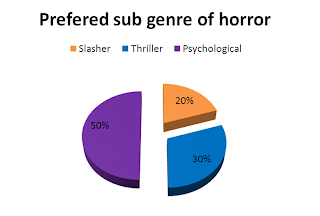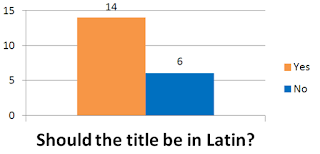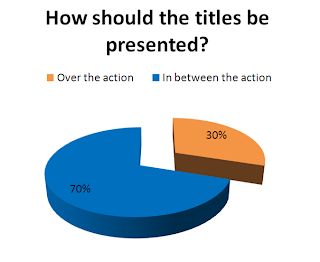I handed out 20 questionnaires to my
target audience to get their feedback on my ideas and to find out what they would expect to see in a horror opening sequence. Based on the feed back I will change my sequence accordingly considering what the target audience want to see.
Here are the results of the questionnaire and how they will affect my choices:
Question 1
How old are you?
As my target audience are teenagers and young adults it was quite easy for me to collect my data. This would have been used to identify who amongst my target audience my ideas most appeal to. Unfortunately my ages aren't too varied as the time allocated to us was not ideal.
Out of the questionnaires
fourteen were 16 years old and four were 17 years old.
Unfortunately this question hasn't presented me with any particular information I can use. But I will be able to tell if this is the right target audience for the sequence. From the positive feedback I can conclude that this is a perfect target audience for my opening sequence.
Question 2
Are you male or female?
This was again an attempt to see who my ideas most appeal to but as I only gave the survey to horror fans I didn't have the time to get an equal amount of each sex.
This shows that this research probably represents the views of males more than females. Also as I asked the participants before giving them the survey if they were a fan of the horror
genre because I didn't want to waste time on collecting irrelevant data.
Question 3
What is your favourite type of horror film?

This question directly relates to the content of my opening sequence. The results show that psychological thrillers is the preferred sub genre of horror. Now when planning my sequence I know that it will be a good idea to include conventions (such as twists, enigma codes etc) from this sub genre because it will appeal to my audience.
Question 4
What are the three things you expect to see in the first few minutes of a horror film?
This was an open ended question to try and get suggestions from the audience of what they expect to see. I am familiar with the
conventions of horror but not all are suited to everybody. I wanted to find out which conventions most appeal to my target audience of young adults.
The top three suggestions were:
As these were very popular I will try to include all of them. As Halloween has just passed I made sure to stock up on props including fake blood so this will not be a problem.
There were also other obscure answers including 'something that is possessed' and even 'a bunny rabbit'. But each of these only occurred once, this means that they are not very popular. I need to include things that will appeal to the widest range of people such as the more popular answers. Therefore there will be no possessed bunny rabbit in my opening sequence.
Question 5
What do you think of the titles being in Latin? Is this A good Idea?

I came up with the idea of the
title being in Latin. I thought of this because the story lines of a lot of horror films have ties into history. It makes the whole thing seem more sinister.
14 out of 20 people agreed that this would be a good idea. As the majority thought this I think I will present the title of my film Latin.
Question 6
What could the title of the film be?
After reading my story line I asked people to come up with some ideas of what the title could be.
Here are some of my favourite suggestions and why I think they are suited:
Somnium - Latin for 'dream'. This would fit with the storyline and the theme of dreams.
Bloody nightmare - I wanted to stay away from the word 'nightmare' because of the similarities to Nightmare on Elm Street. Although it does translate into 'Nocte Cruenta' which would be a good name.
I will do some more audience research into the title of my film to find out what people think of these specific titles.
Question 7
What do you think of the story line?
Here is where I ran in to a bit of trouble. I didn't realise until I collected in and read these questionnaires that my
story line is incredibly similar to that of 'Nightmare on Elm Street'. In one light 'Nightmare on Elm Street' is a very popular film so taking aspects of that story line could be a good idea. The danger comes in the fact that it could end up being too similar. Everyone that didn't recognise the similarity thought it was a really good concept. Some comments I got included 'Great!' and 'Really good would freak me out'.
Based on this I plan to keep my story line relatively unchanged but I will take care to make sure it is not to similar.
Question 8
Blood is used in a lot of horror films, how do you prefer it?

The question is really important. Many horror films shoot them selves in the foot by overusing or under using blood. I need to make sure I get the balance right. If is over used it will look tacky and take away from the credibility of the whole opening sequence. Similarly if it is under used the genre may not be as apparent as I want it to be.
My audience were varied in their opinions. Obviously from my data I can see that somewhere in the middle would be perfect. So I aim to use a realistic amount of blood. But, I don't know how much someone bleeds when they get stabbed, I am not familiar with the realistic amount of blood someone looses if they were to be shot. I need to do some
research on this.
Question 9
What kind of sound do you find scarier?
I don't know much about
soundtracks. From my research the music used can be either subtle, loud or even non-existent. I asked my audience which they find scarier.
I can see clearly that most people find silence and subtle music scarier. Therefore that is what I have decided to use. One of my friends is a very talented musician and I have already asked her to help me out on this. Luckily for me she is more than happy to compose a short piece of music that I can use.
Question 10

Should the opening titles be presented over the action or in between the action?
I was torn as to which technique to use. I feel that over the action titles can draw from the action and be distracting but similarly I think having them on screen in between the titles takes away from the pace.
Fortunately 70% of of the surveys came back saying that they liked the titles to be in between the action. I think I will be able to use this method effectively so this is how I will present my titles.
Question 11
Rate these in order of importance.
I wanted to know what the target audience finds most important in an opening sequence so I know what to focus on when story boarding and scripting. I gave four options, these were; characters, dialogue, action and setting the scene.
The majority ordered them like this:
Most important:
Setting the scene
Second most important:
Action
Second least important:
Establishing the story
Least Important:
Dialogue
I now know how important it is to set the scene and the tone of the film in this opening sequence and that this is what I should focus on. I have also learned that audiences don't expect or need to much dialogue in the introduction of the film.
I will take this into consideration when planning my opening sequence.






















